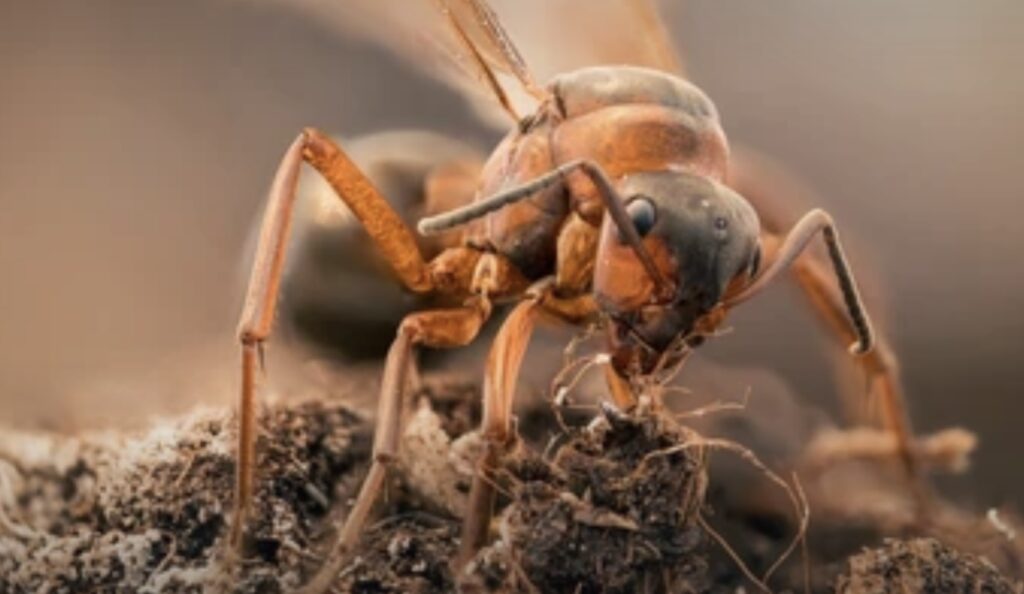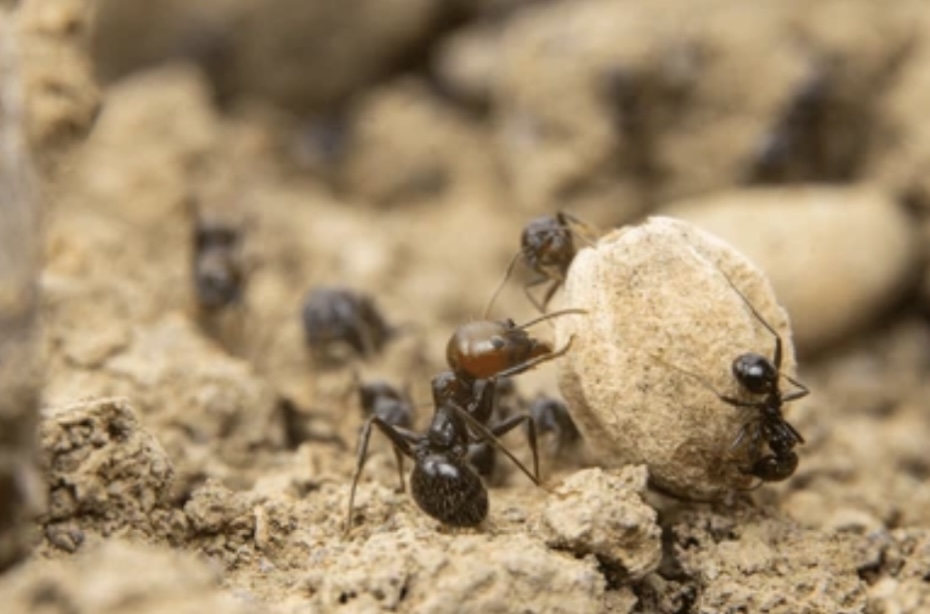Introduction

SOCIAL BEHAVIOUR OF ANTS: Ants are extraordinary creatures, known for their complex social structures, efficient organization, and remarkable cooperative behavior. As eusocial insects, ants live in large colonies where each individual plays a specific role, ensuring the colony’s survival and success. These roles are well-defined, and ants communicate, cooperate, and organize themselves to perform essential tasks such as foraging, defense, brood care, and nest maintenance. The social behavior of ants provides fascinating insights into how cooperation, communication, and specialization work together to make their colonies highly functional and resilient.
In this article, we explore the key aspects of ant social behaviour , including their colony organisation , communication systems, division of labor, and cooperative strategies, which together make them one of the most successful and widespread groups of organisms on Earth.
Colony Structure and Organisation of Ants

Ant colonies are typically organized into a clear hierarchy, with distinct roles for different individuals. This hierarchical structure supports the efficient functioning of the colony, allowing ants to divide labor, communicate effectively, and protect the queen, the colony’s reproductive center.
- The Queen: The queen is the reproductive female at the heart of the colony. In most ant species, there is only one queen or a few queens, and their main role is to lay eggs. A healthy queen can produce thousands of eggs per day, ensuring the growth and survival of the colony. The queen’s pheromones play a crucial role in regulating colony functions, including controlling the reproductive behavior of worker ants.
- Workers: Worker ants are sterile females that make up the majority of the colony. They are responsible for all the labor that sustains the colony, including foraging for food, caring for the brood (eggs, larvae, and pupae), defending the nest, and maintaining the colony’s structure. Worker ants exhibit a high degree of task specialization, and their roles shift with age—young workers tend to stay in the nest to care for the queen and brood, while older workers take on foraging or defensive roles.
- Drones: Drones are male ants whose primary role is reproduction. They do not contribute to colony maintenance or defense. Drones are produced seasonally, usually in the spring or summer, and their sole purpose is to mate with a queen during her mating flight. After mating, drones die, and those that do not mate are typically expelled from the colony.
Communication Through Pheromones
One of the most important features of ant social behavior is their use of pheromones—chemical signals that allow ants to communicate and coordinate with each other. Pheromones are used to convey a wide range of information, from the location of food sources to signals of danger or reproductive status.
- Trail Pheromones: When worker ants find food, they leave behind a trail of pheromones as they return to the colony. This trail is followed by other worker ants, who reinforce the path, increasing the concentration of pheromones. The stronger the pheromone trail, the more ants will be attracted to the food source, enabling the colony to exploit the resource efficiently.
- Alarm Pheromones: When a colony is threatened, ants release alarm pheromones to alert others to danger. These chemicals trigger aggressive or defensive behaviors in other ants, such as swarming the intruder or preparing to fight. Alarm pheromones are highly effective in coordinating a rapid, collective response to potential threats, ensuring the colony’s safety.
- Reproductive Pheromones: The queen secretes special pheromones that help regulate the colony’s reproductive dynamics. These pheromones prevent worker ants from reproducing, ensuring that the queen is the sole reproductive individual in the colony. The queen’s pheromones also help synchronize the timing of reproduction, creating a harmonious balance within the colony.
- Trophallaxis: Ants also exchange food and information through trophallaxis, a process in which ants transfer food or digestive fluids directly to one another through mouth-to-mouth contact. This sharing of food helps nourish the colony and facilitates the transmission of chemical information, such as the discovery of a new food source or changes in the colony’s needs.
Division of Labor and Specialization

Ant colonies thrive because of the division of labor among the workers, allowing ants to specialize in tasks based on age, size, or physical abilities. This specialization maximizes the efficiency of the colony and ensures that all essential functions are carried out.
- Task Specialization: Ant workers are highly specialized in their roles. Younger workers typically remain in the nest, where they care for the brood, clean the nest, and tend to the queen. As they age, they transition to foraging, where they leave the nest to gather food and resources. Older ants may take on the responsibility of defending the colony. In some species, such as army ants, larger workers, known as soldiers, specialize in defense and are equipped with large mandibles to protect the colony.
- Age Polyethism: The division of labor is often based on the age of the worker ants, a concept known as age polyethism. Young workers focus on the nest and brood care, while older workers take on more dangerous or demanding tasks such as foraging and guarding. This age-based division ensures that the colony functions efficiently, with ants performing roles that match their developmental stage.
- Worker Castes: In some species, ants exhibit further specialization into distinct worker castes. For example, in leaf-cutter ants, there are minor workers that cut leaves and major workers that defend the colony. Similarly, in weaver ants, different workers are specialized in nest construction, foraging, or protection. These specialized castes enhance the colony’s ability to complete different tasks simultaneously and efficiently.
Cooperative Foraging and Food Sharing
Ants work together in highly coordinated groups when foraging for food. Cooperative foraging allows ants to gather resources efficiently and ensures the colony has a steady supply of food.
- Cooperative Foraging: When worker ants find a food source, they communicate the discovery to the rest of the colony by laying down a trail of pheromones. Other ants follow the trail, reinforcing it as they travel, until a large number of ants converge on the food source. In some species, like army ants, the entire colony cooperates in aggressive group foraging, where ants work together to overwhelm and capture prey.
- Food Sharing (Trophallaxis): As part of their cooperative behavior, ants share food with one another through trophallaxis. Worker ants exchange food with other ants in the colony, ensuring that all members, including those who do not forage, receive nourishment. This exchange also plays a role in spreading vital chemical information about the colony’s needs.
- Resource Allocation: Ants are skilled at managing and distributing resources within the colony. If food is scarce, worker ants may adjust their foraging behavior or prioritize the collection of more critical resources. This adaptability helps maintain a stable and efficient supply of food, even in challenging conditions.
Colony Defense and Aggression
Ants are highly protective of their colonies and use various strategies to defend themselves against predators, rival ants, or other threats.
- Defense Strategies: Soldier ants with large mandibles or stingers are specifically designed for defense. These ants are tasked with protecting the queen, brood, and the colony’s resources. When the colony is under threat, soldier ants will confront the intruder, using their physical strength to ward off predators.
- Coordinated Defense: In species like fire ants or army ants, the colony can launch coordinated defense efforts, where large numbers of ants swarm together to fight off or overwhelm attackers. Fire ants, for example, will swarm over anything that threatens the colony, using their venomous stings to incapacitate threats.
- Territorial Behavior: Many ant species are territorial and will aggressively defend their nests from intruders, including rival colonies. Ants mark their territory with pheromones, and if another colony encroaches, they will engage in fierce battles to maintain control over their space.
Reproduction and Colony Growth
Ant colonies are founded by a single queen, who mates during a nuptial flight. After mating, the queen establishes a new colony, where she begins laying eggs that hatch into workers. Over time, the colony grows, and the queen may start producing reproductive ants—new queens and males—whose sole purpose is to mate and start new colonies.
- Colony Expansion: As the colony grows, it may eventually produce new queens and males during a process called swarming. These new reproductive ants leave the original colony to mate and establish new nests, ensuring the continued expansion of the species. This reproductive cycle helps maintain genetic diversity and contributes to the long-term survival of the species.
- Colony Fission: In some ant species, when a colony becomes too large, it may undergo colony fission, where a portion of the colony splits off to form a new nest. This process prevents overcrowding and allows the colony to expand without losing its central organization.
Conclusion
The social behavior of ants is a remarkable example of how cooperation, communication, and specialization enable a community to thrive. Through a clear division of labor, effective communication via pheromones, and cooperative foraging and defense, ants create highly efficient and resilient colonies. Their ability to work together as a collective, share resources, and adapt to challenges has allowed them to dominate ecosystems worldwide.
The study of ant social behavior not only deepens our understanding of insect societies but also highlights the power of cooperation in the natural world. From their intricate division of labor to their coordinated defense strategies, ants exemplify the importance of teamwork and organization in achieving long-term success.
Discover more from ZOOLOGYTALKS
Subscribe to get the latest posts sent to your email.

